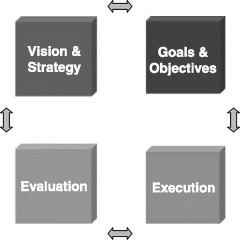Chapter 2. A Model for a Modern Management System
In theory, there is no difference in the activities required to manage a single‐proprietor candy store and those required to manage a business of 100, 1,000, or even 100,000 employees. Regardless of the size of the business, managing it requires four basic activities coming together in what I call the management cycle: vision and strategy; goal and objective setting; execution; and evaluation (see Exhibit 2.1 ).

Figure 2.1. Exhibit 2.1: The Management Cycle
Ideally, the activities in this management cycle should support the purpose of the organization, the means of achieving it, and its ability to adapt. But in actual practice—and especially as businesses grow in size—these activities can quickly become unsynchronized and end up in conflict with one another. For example, in many large organizations, functional departments, and geographic regions disregard corporate strategy in favor of local and parochial considerations. And oftentimes, strategy becomes disconnected from reality, as those who create the strategy are removed from the customers and markets they supposedly serve.
Connecting the Cycle
Ideally, these activities would not exist in isolation from each other and would not occur sequentially. Instead, they would have well‐defined processes to connect them and support the flow of work between them. And they would unfold iteratively, ...
Get The Performance Management Revolution now with the O’Reilly learning platform.
O’Reilly members experience books, live events, courses curated by job role, and more from O’Reilly and nearly 200 top publishers.

